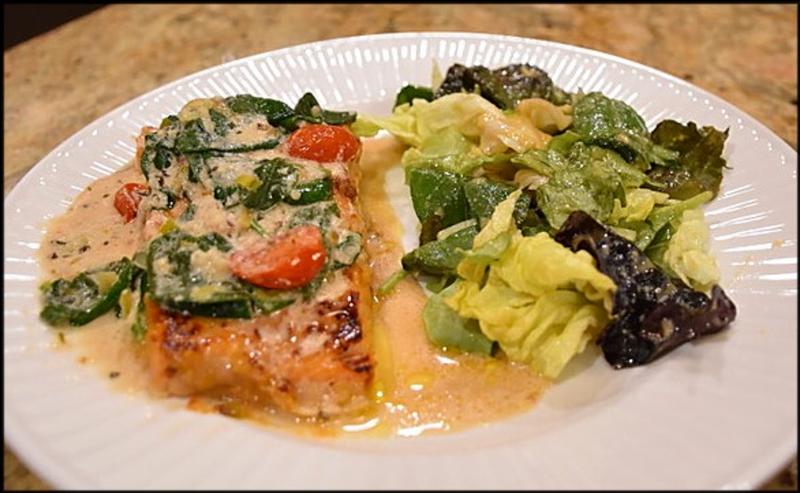Miso adds interest to both sweet and savory dishes
Last week, my friend Bob LaMorte gave me some miso paste, two recipes and this photo of a recent meal he made featuring miso. For those of you unfamiliar with it, miso is considered a “secret ingredient” that adds all-important umami notes to dishes both sweet and savory. From salad dressing to polenta, soup to sauce, miso can balance sugar in caramel or deliver a salty punch to steamed vegetables.
What exactly is this magical substance? Miso is a fermented paste of soybeans and a mold called koji. The color, aroma and flavor of miso paste will vary based on the ratio of soybeans to koji and how long the fermentation period lasts, which can range from weeks to years. This complex ingredient has been used in Japanese cuisine for millennia. As long ago as the year 701, under the reign of Emperor Mommu, a commission was formed to regulate the production, sales and tax policy for miso.
While the creation of miso paste may seem daunting, we can readily purchase it here, where we have many local sources for high-quality miso. At the grocery or specialty market, you will find two varieties: sweet (sometimes called white, which does not accurately describe its color) and dark (often called red or brown). Once the package is opened, you can keep the paste under refrigeration for up to a year in a tightly sealed container. Don’t be concerned if it darkens over time; that is normal.
Although its flavor has been described as rich, earthy and salty, I would advise against tasting miso paste right out of the jar; reserve judgment until after you have stirred it into a dish. And, the darker, saltier and more pungent miso paste, which has a longer fermentation time, might not be the place to start. Most professional chefs recommended beginning with a lighter-colored, sweet miso as an introduction.
The primary role of miso in a dish is as an accent, rather than a front-and-center ingredient. I used the miso paste from Bob to add richness to an onion gravy for roast chicken and to add some interest to a vegetable-broth-based soup. In both cases, it worked just as designed, adding salty hints and rich flavor notes. You can find recipes that use sweet miso in blondies, cookies and pies, while the dark miso is better for heartier dishes like stews or braises.
For the salad in the photo, Bob used miso to create a dressing for baby greens, seasoning the mixture with sesame oil and ginger. His version calls for ground ginger, but you can substitute grated fresh ginger if you have some on hand. The miso gives the vinaigrette a lovely texture so it coats the lettuce beautifully.
Bob’s salmon recipe uses the technique called “sous vide,” where food is placed in a sealed plastic bag and cooked in a circulating hot-water bath. If you don’t have a sous vide device, you could bake the salmon while you prepare the sauce. The benefit to sous vide is the precision it offers, giving you the ability to cook the salmon to the exact degree of doneness.
Now that I’ve had the chance to experiment with this special ingredient, I’ll remember to reach for miso paste the next time I need to add extra interest to a dish. Thank you, Bob, for the introduction to miso paste!
Bob’s Miso Salad Dressing
2 t olive oil
2 T rice wine vinegar
4 t white miso paste
1 1/2 t toasted sesame oil
1/8 t ground ginger
Whisk together oil, vinegar, miso, sesame oil and ginger in a serving bowl until smooth. Toss with baby lettuce, grated carrots and halved cherry tomatoes.
Bob’s Sous Vide Miso Salmon
2 salmon filets
1/3 C miso paste
3 minced garlic cloves
1 sliced green onion
1 T grated ginger
1 T sambal chili paste
Set sous vide temperature to 115 F. Whisk together miso, garlic, onion, ginger and chili paste. Coat the salmon filets and seal in plastic bag. Place in sous vide pot and cook for 45 minutes. Remove from bag and sear in an oiled skillet to finish, about 1 minute for each side. Serve with Creamy Garlic Sauce.
Bob’s Creamy Garlic Sauce
2 T butter
1/2 chopped onion
1 1/2 C halved cherry tomatoes
6 minced garlic cloves
1/4 C vegetable broth
1 1/2 C half and half
1 t garlic powder
1/2 t oregano
1/2 t basil
1/2 t thyme
1/4 t cayenne
1 T Balsamic vinegar
3 C packed baby spinach
Melt butter in a skillet over medium. Add onion and sauté until translucent, about 3 minutes. Add garlic and tomatoes; cook until garlic is fragrant, about a minute. Stir in broth. Add half and half, and bring to a boil. Reduce heat to medium and add seasonings. Add balsamic vinegar and continue to cook, while stirring, until sauce begins to thicken, about 5 minutes. Add spinach and cook until it is wilted, about 3






















































